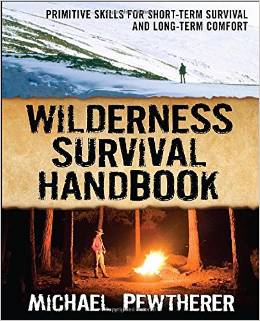Wilderness Survival Handbook – A Review
I read and studied this book, “Wilderness Survival Handbook by Michael Pewtherer” two or three years ago and found it a good read chock full of important information. If a person has studied survival topics much they will always find repeated information, however it is still valuable as it reinforces what has already been learned, also at times things are presented in a different way which helps ones understanding.
If there was one word to describe this book it would be “details” Michael gives lots of information that others do not include. Let me now take you into the book so you can get the flavor of it.
The author divides the book into two main sections 1) Seven Day Survival, 2) Beyond Survival – Primitive Skills for Wilderness Living. This is handy for the reader and student as most of the time a person would only need about three days before rescue, since the first part of the book deals with that, it lays a good foundation. Many survival books deal with a list of skills, many of which may not be needed in the typical three day scenario, nothing wrong with knowing more, but the layout in this book gets a person off to a good start, then adds much more in the last section.
Seven Day Survival
The chapter headings indicate the subject matter thoroughly covered in this part of the book
- Preparing to Survive
- Shelter
- Water
- Fire
- Navigation
- Medical Emergencies
You will notice the proper priority of these subjects generally and also note that he does not involve food in any way, as obtaining food is not at all necessary in a seven day survival scenario, nor even for two weeks as I have noted here in past blogs and videos, yet it is the primary item first covered by many authors who write about survival.
The author gives plenty of detail in explaining things, that detail generally includes stories of his own experience learning and doing the things he is teaching. The Squirrel Nest and Debris Hut shelters are two examples. I remember many years ago when I was trying out leaf shelters, which are what he calls a Squirrel Nest. I built a back wall out of sticks and a foot and head wall, then I piled in leaves till I was tired of it. The leaf pile was nearly four feet thick. My thinking at the time was to just burrow in from the side. I quickly found out that one or two movements left me with no leaf cover. Later I built a debris hut with a thick layer on top and then I filled the inside with leaves as well. I had a cozy sleep inside, and the rain that night did not penetrate to me. Michael relates his learning experience as he tells how to build these shelters. He spends eight pages on debris huts alone and includes illustrations.
Examples of detail shared pertaining to Debris Hut Shelter
- The ridgepole should be longer than you are by about two feet
- The ridgepole should be about waist high at the head end
- Double check the height of the head end by laying on your side, your shoulder should be a hands length below the ridgepole.
He offers many other details and tips. Any person should be able to construct a debris hut from the directions given.
Water – the section on water is ten pages long, the following are examples of details he offers that many others do not know or simply leave out.
- The best action to take in any environment, desert or otherwise, it to drink water
- To purify water a rolling boil for one minute at elevations below 6500 feet, three minutes if above
- To find water, look for places with green moss or lots of insect activity
- Solar Stills – “I must say that, as a survival tool, the solar still is greatly overrated.”
- Water collected from a transpiration bag, depending on the plant, can be quite nasty to drink
- Water from the pulp of a barrel cactus, “is more likely to make you vomit up valuable liquid than it is to quench your thirst.”
- Sap gathering in spring and fall – “it is possible to collect more than a gallon of sap a day from a single tree”
There is so much more in the book, I have not even touched the surface of that which is covered in such an easy to read and understand method of writing. The above selections are taken from the first part of the book.
Beyond Survival – Primitive Skills for Wilderness Living
The chapter headings in this section are well worth noting to indicate the extensive subject matter the author deals with in the second part of the book. Without being too wordy he explains thoroughly many details in these chapters that are simply not even touched on by many other authors. In many books a technique or skill is mentioned but not enough information is given for a person to accomplish it.
- Shelters for the Long Term
- Fire making Tools
- Food and Drink
- Fishing
- Trapping
- Hunting Weapons
- Hunting Methods
- Rawhide Tanning Hides for Buckskin and Sinew
- Cordage and Crude Cloth
- Other Tools and Materials
- Containers
- Comfort and Cleanliness
- lastly: Recommended Reading
Again for this section I will choose a few highlight comments so you can get an idea of what is talked about. It is worth noting that Chapter 9 Food and Drink does not deal with obtaining food and drink, but rather with preparing, cooking, storing and preserving food. There are four chapters that deal with obtaining food.
- The author devotes nine pages just to the Atlatl with plenty of detail and illustrations
- There are two primary throwing methods, the split finger grip and the hammer grip. Pictures and description of each are provided as well as the authors favorite and why.
- Not only does Michael detail the making of cordage, which can be invaluable to the person staying in the wilds long term, but he also delves into the making of a simple weaving loom for making blankets, ponchos, and such. With the illustration and detail given a person could successfully start such a project. Having done this myself before in making door mats for each camp at a week long family camp I find he author’s information suitable.
- The start of Chapter 17 Containers begins with the authors statement as follows
- “The value of a container is often overlooked until you have none. How to carry, cook or hold the items and foods that we need for survival with no container does not at first glance appear to be a pressing question. Roasting is a fine way to cook many wild meals, but what about drinks and soupy meals? Containers are worth a lot and knowing to to make them for whatever your needs is worth the time.”
- Pottery-there are 26 pages devoted to producing primitive pottery in the wilds, nicely detailed.
- Shelter tip: “People usually build their hut too large; the amount of space that a person actually needs is pretty small.”
I could go on and on about this book, but it’s best for you to just get it and study it for yourself. Notice I didn’t say read it, but rather study it. If you intend to get anything useful from a book, you must study it!
Until next time, this is Perry Peacock, “Simplifying Survival”




Perry,
I emailed you last year or so. I see that you are in Mt. Pleasant now (or is that just the shop). I just purchased me a very rugged (although a bit heavy) backpack and have recently discovered something. As I mentioned before, I spent many years in the wilderness as an infantryman and combat tracker. Now, however, I find myself in a dilemma. While serving with Uncle Sam (we called him Uncle Sugar), I carried mostly ammo and six rations (two per day). I figured I was a stud then and knew my way around the wilds. Now as a civilian I have discovered how spoiled and dependent I was on resupply. Yeah, we roughed it plenty and I drank some pretty nasty water purification tablet tainted water and once a mouth full of tadpoles from a night canteen fill. A time or two we had to go without because of the tactical situation (I’ve had more than my fair share of heat injuries and starvation diets).
I guess what I’m trying to say is, my biggest weakness is in living off the land. Especially in identifying what is edible and what is not. The courses I received in the military were conducted in a virtual garden of eden as opposed to here in Utah (I live in Tooele County). Are you going to teach a class that addresses such issues sometime in the future? Please. I need help.
Regards,
Kayle
Kayle,
Now that our shop is set up and operating, I’m working on starting up some classes finally. There are some folks from Texas want to come out for some training, mostly practical survival tailored around effective use of our gear. Right now its been classes by request. I’m hoping to do something in the early fall.
Perry